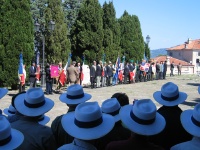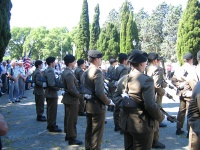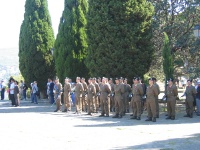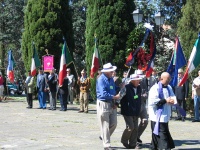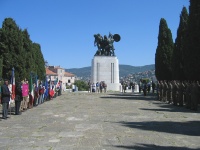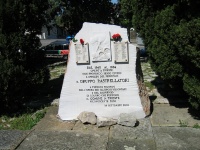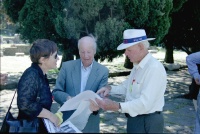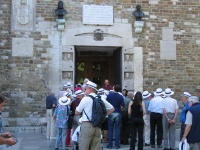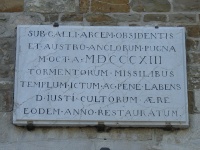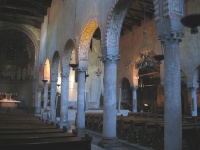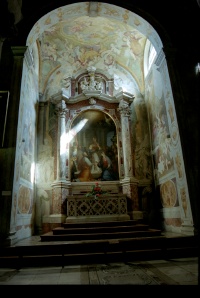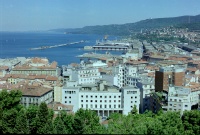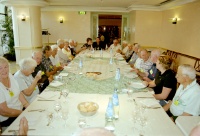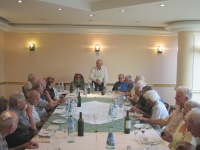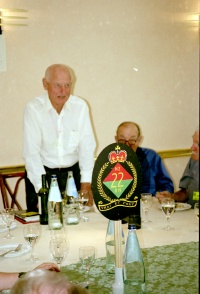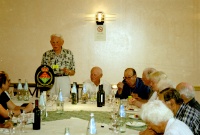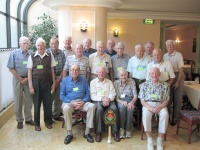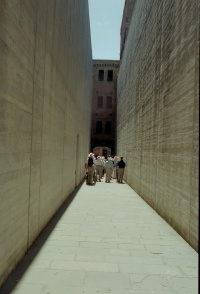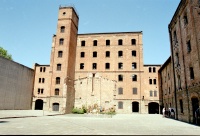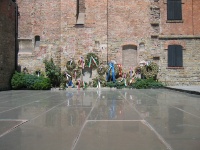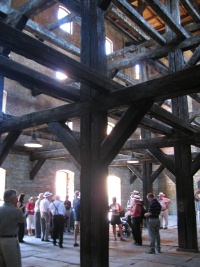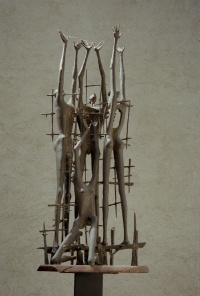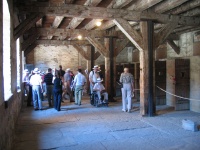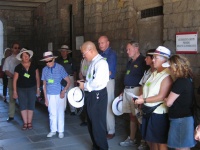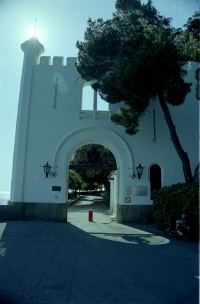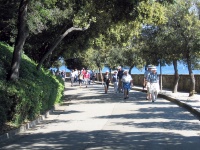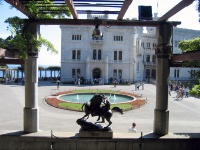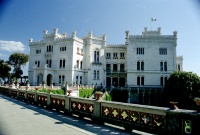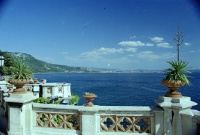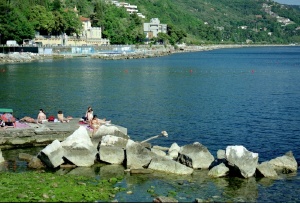WEEK 1
DAY 6 Thursday 26 May 2005
The War Memorial at San Giusto
At 1000 we departed by bus to climb the hill that overlooks Trieste.
Here lies the
Castle of San Giusto and the Church of the same name. Beside the Castle
is a parade ground and towering War
Memorial, where we were met by an Italian Army honour guard and a
parade of flags and
banners from many Italian, American and British units. After a round of
speeches, the New Zealand veterans
laid a wreath.
|
The Parade Ground at San Giusto with a honour guard of Italian,
American and British units |
The Italian Army Guard |
The Italian Army Guard |
|
Marching forward with wreath |
View towards the Memorial with the wreath party |
One of several commemorative stones adjoining the ground |
| You
can click on each photo for a larger image (use your browser's Back
button to return to this page)
|
Following the ceremony, a number of
Triestini came forward to
talk to the veterans and to thank them for past efforts. One person in
particular sought out Haddon Donald and showed him pictures taken the
day Haddon
had arrived in Trieste in his jeep. He also had a copy of a book of
photographs
recording events of the time that he presented to Haddon. I have
subsequently
obtained a copy of the book (in Italian, and the photos relating to the
events
of 2 May 1945, can
be viewed here....)
The Cathedral of San Giusto
Following the wreath-laying, we were able to visit the Cathedral San
Giusto,
which has elaborate frescos and wonderful architecture like all of the
Italian
churches. It was completed in the 14th century on the site of earlier
Roman
ruins.
|
The entrance to the Cathedral of San Giusto |
Stone inscription over the entrance |
|
Columns inside the Cathedral |
One of several frescos inside the Cathedral |
The Castle of San Giusto
Looking over the city and
harbour of Trieste with unparalleled views, is the Castle of San
Giusto.
It was built on the site of a Roman villa, and earlier castles by the
Venetians
between 1470 and 1630. The Castle was substantially restored following
archaeological excavations in the early 1930s.
San Giusto Castle played an
important role for the New Zealanders who arrived in Trieste on 2 May
1945.
|
The Official History p542 records:
"Colonel Donald,
accompanied by two German officers, endeavoured to obtain the surrender
of the garrison still holding out in the Tribunale (law courts) in
Trieste.
He also led some armoured cars, tanks, and C Company of 22 Battalion to
the 700-year-old fortified castle, the >Castello
San Giusto, on the hill in the centre of the city, where he
left Major Cross to accept
the surrender of the garrison while he himself returned to the
Tribunale.
C Company was
greeted at the castle about 5.30 p.m. by much indiscriminate shooting.
The Germans fired a bazooka at one of the tanks, but missed. Yugoslav
troops threatened to shoot anyone who went into the castle, but C
Company passed through the gates and entered the courtyard, where the
Germans were waiting. The garrison of 12 officers and 170 men was
disarmed, and 13 Platoon took up positions previously occupied by the
Germans. The castle was well stocked with ammunition and prepared for
siege."
|
|
The port of Trieste from the rampart of San Giusto Castle |

22nd Battalion Lunch at
Hotel Jolly Trieste
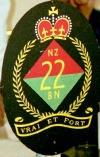
By a quirk of circumstance,
there were 18 veterans on our tour that had served with the 22nd Army
Battalion
in Italy. Their Commanding Officer at the time of the liberation of
Trieste was
Lt Colonel Haddon Donald, who promptly suggested that a lunch for the
Battalion
be organised. I arranged with the Hotel in Trieste for a special lunch,
which
was attended by 17 veterans (one being confined to bed for the day) and
accompanying family, making a party of 26 diners.
The Lunch was a wonderful
occasion to meet as a group, to share the time and the memories, to
thank people
present and past for their contributions and to raise a Toast once
again to the
battalion. With great reluctance the group acknowledged that this would
be the
last time that so many 22 people would meet in Italy. A group photo
commemorates
the time.
|
The 22 Battalion Lunch party |
More of the party |
Co Haddon Donald addressing the Battalion |
|
Haddon Donald and Lloyd Cross (obscured) |
Douglas Froggatt thanking the group |
The 22 Battalion members after the lunch |
Risiera di San Sabba -
Monumento Nazionale
At 1400 hours we boarded the
buses for the drive to the Risiera - the Rice factory. Our tour notes
had listed
this as a Nazi Prison, but this had not alerted people to the reality
of the
place. The German Army had maintained the factory for drying rice, but
in March
1944 they converted it to a prison camp and crematorium, using a design
by Erwin
Lambert who had designed crematoria in Poland. It was first used in
April 1944.
The prison was used to house people rounded up before transport to
other camps
outside Italy. Estimates of the number of people who died at the prison
range
from three to five thousand. It was the only concentration camp
operated by the
Nazis outside Germany/Poland.
On the night of 29th April
1945 the crematorium and chimney were destroyed by the Germans. Three
days later
the New Zealanders drove into Trieste.
|
The entrance to the Risiera |
Our group in the entrance |
The central courtyard and the rice store |
|
The remains of the crematorium |
The memorial on the site of the crematorium |
Exposed beams in the Risiera |
Despite knowing in advance
what we were visiting, the place, now a National Monument, came as a
shock to
all. The buildings, the high walls, the unerring quiet of the place
deeply
saddened everybody and cast a sombre cloud over the tour. But
that is why
such sites have been preserved, and why it was an important part of the
tour of
Trieste - to remind us of the events of those times, and to again
reinforce why
the Triestini hold the New Zealanders in such high regard. We noted
with pride a
large group of school children sitting quietly in the shade of the high
walls.
On being told of our presence and who we were they rose and applauded
our
veterans. It was a touching moment.<
|
The sculpture inside the building |
View of the holding cells |
Father Michael remembering the dead |
Miramare Castle
Later in the afternoon the
buses took us along the coast road to Miramare Castle. The elaborate
castle
built from white marble sits on a promontory into the Adriatic Sea,
with
wonderful views across to Trieste. The Castle was built in 1856-1860
for the
Governor of Trieste, Archduke Maximilian of Hapsburg and his wife
Charlotte of
Belgium. Maximilian had spent his early life at sea, and the
interior was
designed to resemble a ship. However before completion, Maximilian was
appointed
Emperor of Mexico leaving Charlotte behind. Maximilian was killed in
Mexico so
never slept in the completed Castle. (More
info......)
In 1945 the New Zealand
troops used Miramare Castle as their divisional HQ, being quartered
their for
several months before their return to New Zealand. The large German
flag that
hung in the entranceway when the Castle was entered on 3 May 1945 was
"captured" by a New Zealand soldier and is now in the Waiouru Army
Museum.
Today Miramare has been
restored, most of Maximilian's furniture has been returned, and the
Castle is
now a museum.
|
The imposing entrance to Miramare Castle |
Walking up the road as it curves around the coast towards the Castle |
The entrance to the building looking across the courtyard and garden |
|
Reverse view of photo looking at the building |
The main Castle |
From the front of the Castle looking towards Trieste |
|
Panorama of Trieste and the head of the Adriatic Sea from Miramare
Castle |
|
View of the beach and coast from the entrance to Miramare Castle. |
When
I returned to
the bus park at the entrance to Miramare, I noticed that our bus
drivers were
taking an unusual interest in the view over the bay, especially those
sunbathing
on the breakwater. They asked if they could borrow my camera with
telephoto lens
and this is "What the drivers
Saw".
Go
to Next Day in Diary - Friday
Go
to Previous Day in Diary - Wednesday
Return
to Trip
Index
Last
updated: 21/09/2010
|
